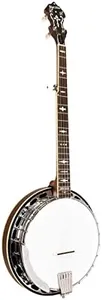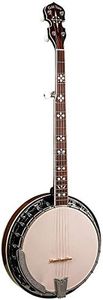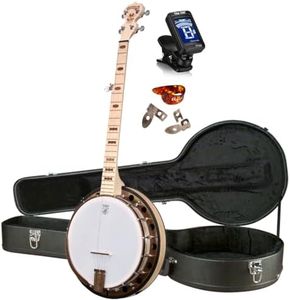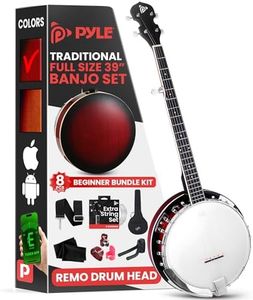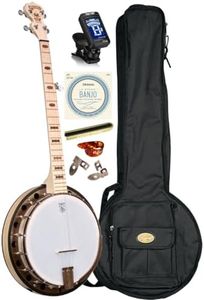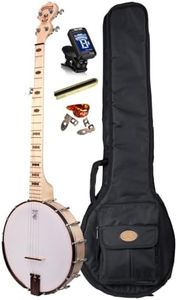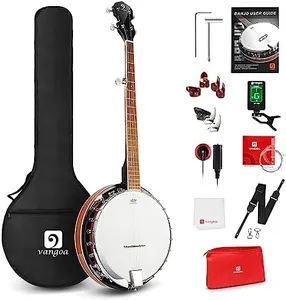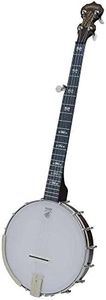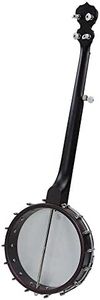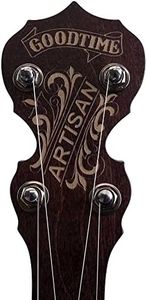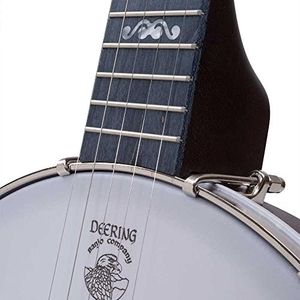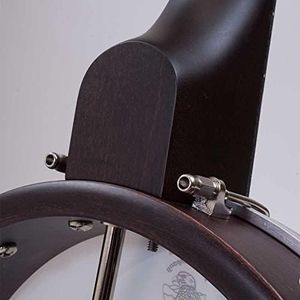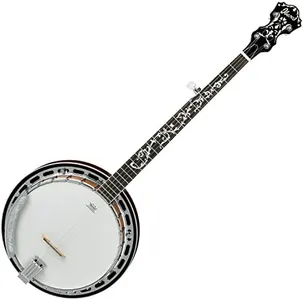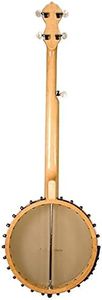10 Best Banjos 2025 in the United States
Winner
Deering Goodtime BLACKGRASS 5-String Bluegrass Banjo with Hard Case - All-Black Resonator, Neck and Hardware - Midnight
Deering Goodtime BLACKGRASS 5-String Bluegrass Banjo with Hard Case - All-Black Resonator, Neck and Hardware - Midnight
Chosen by 1390 this week
Gold Tone OB-150: Orange Blossom Banjo with Case, 5-String Banjo
Gold Tone OB-150: Orange Blossom Banjo with Case, 5-String Banjo
Gold Tone BG-150F Banjo
Gold Tone BG-150F Banjo
Gold Tone AC-1: 5-String Beginnner Banjo, Full Size with Gig-Bag, Bluegrass or Clawhammer
Gold Tone AC-1: 5-String Beginnner Banjo, Full Size with Gig-Bag, Bluegrass or Clawhammer
Deering Goodtime 2 5-String Maple Resonator Bluegrass Banjo 1920's Art Deco Inlay Bronze Powder Coat Hardware with Instrument Alley Hard Case Combo
Deering Goodtime 2 5-String Maple Resonator Bluegrass Banjo 1920's Art Deco Inlay Bronze Powder Coat Hardware with Instrument Alley Hard Case Combo
Vangoa Banjo 5 String Full Size Banjos Set with Resonator, Remo Head, Beginner Banjo Kit with Closed Back, Premium Accessories for Adults, Teenager
Vangoa Banjo 5 String Full Size Banjos Set with Resonator, Remo Head, Beginner Banjo Kit with Closed Back, Premium Accessories for Adults, Teenager
Deering Artisan Goodtime 5 String Openback Banjo
Deering Artisan Goodtime 5 String Openback Banjo
Blackgrass Goodtime 5-String Banjo by Deering
Blackgrass Goodtime 5-String Banjo by Deering
Ibanez B200 Banjo - Natural
Ibanez B200 Banjo - Natural
Gold Tone CC-Carlin12: Cripple Creek Bob Carlin Banjo with Gig Bag - 12 Inch Pot w/Scoop Clawhammer Banjo
Gold Tone CC-Carlin12: Cripple Creek Bob Carlin Banjo with Gig Bag - 12 Inch Pot w/Scoop Clawhammer Banjo
Our technology thoroughly searches through the online shopping world, reviewing hundreds of sites. We then process and analyze this information, updating in real-time to bring you the latest top-rated products. This way, you always get the best and most current options available.

Our Top Picks
Winner
Deering Goodtime BLACKGRASS 5-String Bluegrass Banjo with Hard Case - All-Black Resonator, Neck and Hardware - Midnight
The Deering Goodtime BLACKGRASS 5-String Bluegrass Banjo stands out primarily due to its striking all-black design, making it a visually appealing choice for players who appreciate aesthetics alongside performance. This banjo features a comfortable 'D' shape neck crafted from premium rock maple, which ensures a smooth playing experience. With 22 pressed nickel silver frets, it provides good playability, especially for those who enjoy playing bluegrass music. The 11" high crown frosted head and 3-ply violin-grade maple rim contribute to its bright and resonant sound, suitable for traditional bluegrass styles.
One of the advantages of this banjo is its durable matte black powder hardware finish, which not only enhances its appearance but also protects against wear and tear. The inclusion of a hard case in the bundle is a great addition for players who need to transport their instrument safely.
While the banjo is a solid choice for beginners and intermediate players, it weighs around 13.77 pounds, which could be considered heavy for some, especially when transporting or playing for extended periods. Additionally, those looking for a more traditional wood finish may find the all-black design a bit unconventional.
Gold Tone OB-150: Orange Blossom Banjo with Case, 5-String Banjo
Most important from
14 reviews
The Gold Tone OB-150 is a well-crafted 5-string banjo that stands out for its resonator design, making it a solid choice for those interested in bluegrass or folk music. The 11" brass flat top tone ring and 3-ply maple rim contribute to a rich, bright sound, ideal for projecting in ensemble settings. With a scale length of 26-1/4", it caters well to both beginner and intermediate players looking for playability without sacrificing tone quality. The fingerboard made of rosewood offers a smooth feel, enhancing playability.
One of the key strengths of the OB-150 is its build quality. The one-piece cast flange and solid maple construction provide durability and stability, while the engraved armrest adds a touch of elegance. Weighing in at about 11.48 pounds, it is reasonably lightweight, making it manageable for longer playing sessions.
There are a few considerations to keep in mind. As a resonator banjo, it may not be as suitable for players looking for a softer, more mellow tone that open-back models provide. Some users might find the satin finish less appealing if they prefer a more glossy look. Additionally, while the banjo's weight is manageable, it may be slightly heavy for absolute beginners or younger players.
Most important from
14 reviews
Gold Tone BG-150F Banjo
The Gold Tone BG-150F Banjo is a 5-string resonator banjo, making it suitable for bluegrass and other styles where a louder, richer sound is desired. It's equipped with a rolled brass tone ring, which helps produce a bright and vibrant sound. The maple neck and body contribute to the instrument's durability and a clear tone. The banjo also features a flat flange and hearts and flowers inlay, adding aesthetic appeal.
Key strengths include its 26.19-inch scale length, which is standard and comfortable for most players, and a rosewood fretboard which offers a smooth playing experience. At 9 pounds, it is relatively lightweight for a resonator banjo, making it easier to handle during long playing sessions. Additionally, its chrome plating provides a sleek finish that also protects against wear.
However, there are a few potential drawbacks. While the banjo's weight is manageable, beginners might still find it slightly heavy compared to starting models. Also, the tone ring, while beneficial for sound quality, adds to the cost, potentially making it less accessible for budget-conscious buyers.





